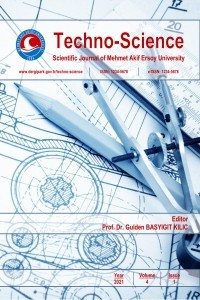Investigation of combined effect of nanofluid and swirling jet on heat transfer
Investigation of combined effect of nanofluid and swirling jet on heat transfer
The present study is focused on the numerical investigation of heat transfer from a heated surface by using nanofluids and swirling jets. Effects of different Reynolds number and different inlet temperature on heat transfer and fluid flow were studied numerically. Al2O3- H2O nanofluid was used as a base coolant in all parameters. k-ω turbulent model of PHOENICS computational fluid dynamics code was used for numerical analysis. It is obtained that increasing Reynolds number from Re=12000 to 21000 causes an increase of 51.3% on average Nusselt Number. Increasing inlet temperature from Tinlet=5 ºC to 30 ºC has not a significant effect on average Nusselt number.
Keywords:
Computational Fluid Dynamics, Heat Transfer Nanofluid,
___
- [1] Kharoua, N., Khezzar L., Alshehhi M., (2018). The interaction of confined swirling flow with conical bluff body: numerical simulation. Chemical engineering research and design, vol.136, p .207-218.
- [2] Chang F., Dhir VK., (1993). Heat transfer enhancement and turbulent flow field in tangentially injected swirl flows in tubes. American Society of Mechanical Engineers Heat Transfer Division, vol. 256, p.37-48.
- [3] Kilic, M., Calisir, T., Baskaya, S., (2017). Experimental and numerical study of heat transfer from a heated flat plate in a rectangular channel with an impinging Jet, Journal of the Brazilian Society of Mechanical Sciences and Engineering. vol.39, 1, p.329-344.
- [4] Kilic, M., Baskaya, S., (2017). Improvement of heat transfer from high heat flux surfaces by using vortex promoters with different geometries and impinging jets. Journal of the Faculty of Engineering and Architecture of Gazi University, vol.32 number (3), p.693-707.
- [5] Teamah, M. A., Dawood, M.M., Shehata, (2016). A Numerical and experimental investigation of flow structure and behavior of nanofluids flow impingement on horizontal flat plate, Experimental Thermal and Fluid Science, vol.74, p. 235-246.
- [6] Sun, B., Qu, Y., Yang, D., (2016). Heat transfer of Single Impinging jet with Cu nanofluids, Applied Thermal Engineering, vol.102 p.701-707.
- [7] Kilic, M., Ali H.M., (2018). Numerical investigation of combined effect of nanofluids and multiple impinging jets on heat transfer, Thermal Science, , DOI:10.2298/TSCI171204094K.
- [8] Sekrani, G., Poncet, S., Proulx, P., (2018). Modelling of convective turbulent heat transfer of water-based Al2O3 nanofluids in an uniformly heated pipe, Chemical Engineering Science, vol.176, p.205-219.
- [9] Wongcharee, K., Chuwattanakul, v., Eiamsa-ard, S., (2017). Heat transfer of swirling impinging jets with TiO2-water nanofluids, Chemical Engineering and Porcessing, vol.114, p.16-23.
- [10] Akyurek, E.F., Geliş, K., Şahin, B., Manay, E., (2018). Experimental Anlaysis of nanaofluid with wire coil turbulators in a concentric tube heat exchanger, Results in Physics,vol. 9, p. 376-389.
- [11] Corcione, M., (2011. Empirical correlating quations for predicting the effective thermal conductivity and dynamic viscosity of nanofluids, Energy Conversation Management, vol. 52, number.1, p.789-93.
- Yayın Aralığı: Yılda 2 Sayı
- Başlangıç: 2018
- Yayıncı: Burdur Mehmet Akif Ersoy Üniversitesi
Sayıdaki Diğer Makaleler
Dehydration of vegetables by using indirect solar dryer
Younas KHAN, Jafar Khan KASİ, Ajab Khan KASİ
Abdullah Onur ÖZDEMİR, Bayram KILIÇ, Emre ARABACI, Recep Çağrı ORMAN
Design, development and control of long range quadcopter
Syed NAJEEBULLAH, Ajab Khan KASİ, Jafar Khan KASİ
Web based tracking of vehicle fault and performance data on OBD II
Ahmet Ali SÜZEN, Kıyas KAYAALP
Investigation of combined effect of nanofluid and swirling jet on heat transfer
